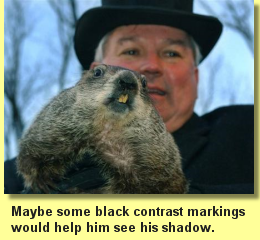 |
 |
Groundhog DayBy Mike Speidel
With all the hype that surrounds Groundhog Day, you would think he would turn out to be astonishingly accurate. However, according to Wikipedia, Phil has forecasted correctly just thirty-nine percent of the time dating back to 1887. That's an old groundhog! It's not that I harbor any ill will against Phil or groundhogs in general (although the preceding paragraph may lead you to believe otherwise), it has more to do with the process that is logically frustrating. Besides, if I'm going to consult an animal for insight about the change of seasons, I would go straight to an owl - or a hawk in a pinch. What does this have to do with airfield markings? I'm elated you asked! Tradition doesn't always pay off. The traditional method of painting the entire airfield every year doesn't make logical sense, just as relying on an overweight land-beaver for tips on the weather is ridiculous! Whether a Part 139 inspection is nearing or lack of maintenance criteria compels airports to "just paint it all"; the tradition doesn't pay off. Couple that with traditionally poor application practices, and even a groundhog would find the error in logic. As an industry we must get away from "the way we've always done it" and develop a new strategy to employ the best practices. If there's one thing the aviation industry specializes in, it's innovation. There are tools available to assist in the development of a new, innovative method to maintaining your airfield markings. One is Sightline's regional training courses, the Airfield Marking Symposium. In essence, it's a two-day course, half classroom, half field demonstration, on the best practices involved in painting airfields. The Airfield Marking Handbook is the course literature encompassing everything from the start of a project to its completion: specification writing/project design, material selection, surface preparation, paint removal, equipment, application procedures and inspection techniques. We'll be in Dallas in May. Another tool is an Airfield Marking Audit, including our Marking Condition Index (MCI). Like a Pavement Condition Index (PCI) the MCI surveys solely the condition of the markings. Derived from the findings, a multi-year maintenance plan is developed prioritizing markings to be maintained or perhaps deferred to subsequent years. Included in the maintenance plan are annual estimates based upon scope of work for each year. In addition, we make suitable material and/or equipment recommendations tailored to the needs of the airport, if required. If you need references, we will provide them. Get an estimate. These innovations help our clients adapt the traditional method of painting everything irrespective of need. Sightline airports realize long term savings in materials and labor, and reduce build up that could produce FOD and therefore liability; all resulting from a relatively small change to tradition. Now if only someone could help that groundhog... |

 February 2nd marked another historic day this year on which millions of people eagerly awaited news from
a groundhog. It's the day where an oversized buck-toothed squirrel predicts an early painting season (spring) or an
extended winter. The entire town essentially stops as local celebrity "Punxsutawney Phil" inspects his own fat shadow, squints
his beady little eyes and forecasts the future. Phil might be the worst meteorologist of all time.
February 2nd marked another historic day this year on which millions of people eagerly awaited news from
a groundhog. It's the day where an oversized buck-toothed squirrel predicts an early painting season (spring) or an
extended winter. The entire town essentially stops as local celebrity "Punxsutawney Phil" inspects his own fat shadow, squints
his beady little eyes and forecasts the future. Phil might be the worst meteorologist of all time.